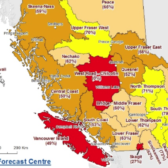New plan provides roadmap for addressing health risks of gambling
The B.C. government is stepping up its efforts to address public-health risks of gambling with a new plan that outlines how the Province and B.C. Lottery Corporation will work to address problem gambling and improve programs and services aimed at promoting responsible gambling.
The Plan for Public Health and Gambling, released today, contains 21 commitments focused on four main themes: problem gambling prevention among youth, encouraging responsible gambling, problem gambling treatment, and research.
“The B.C. government is already recognized as a leader in responsible gambling education and the prevention and treatment of problem gambling,” said Finance Minister Michael de Jong.
“The commitments in this plan will strengthen and enhance our programs, support British Columbians with gambling problems, and help further reduce the rate of problem gambling in B.C.”
The plan takes into consideration a range of research on the of impacts of gambling on individuals and communities in B.C., including the 2014 Problem Gambling Prevalence Study, the provincial health officer’s report on gambling, online gambling research and other relevant data on gaming, health and education.
The key elements of the plan include:
- Improving the delivery of problem gambling prevention programs for youth with an increased focus on problem solving, critical thinking and building resilience.
- Adding customized responsible gambling messaging on PlayNow.com, B.C. Lottery Corporation’s on-line gaming portal.
- Expanding the successful GameSense Advisor model to community gaming centres, in addition to what is already in place in casinos.
- Increasing co-operation between the ministries of Finance and Health to improve continuity of care for clients who face multiple, related problems such as gambling, substance abuse and mental-health issues.
- Investing in research to understand problem gambling among online players and to determine the impact of reducing high-risk features on electronic gaming machines.
- Government and BCLC will monitor the progress and achievements of the Centre for Gambling Research at the University of British Columbia. Funding of $2 million over five years has been provided for the centre.
The Plan for Public Health and Gambling was developed by the Gaming Policy and Enforcement Branch of the Ministry of Finance, in conjunction with the Ministries of Health and Education and the B.C. Lottery Corporation. BCLC has agreed to work closely with government to implement action items involving the corporation.
Quick Facts:
In 2014, there were 125,000 problems gamblers (about 3.3% of the population). In 2008, 159,000 people were classified as problem gamblers (about 4.6% of the population).
- Over one-third (36.4%) of at-risk/problem gamblers reported that they had experienced a mental-health issue. 13.5% of non-problem gamblers reported experiencing a mental-health issue.
- Although young adults 18 to 24 years of age were the least likely age group to gamble, they were most likely to experience problem gambling relative to other age groups. Among 18-to-24-year-olds, 7.3% were classified as problem gamblers, and 18.4% were classified as at-risk/problem gamblers.
- 34.7% of at-risk/problem gamblers reported using drugs or alcohol while gambling compared to 19.2% of non-problem gamblers.
- At-risk problem gamblers were significantly more likely than non-problem gamblers to use electronic gaming machines outside of a gaming facility (6.4% vs. 2.7%).
- The percentage of respondents who self-reported participation in Internet gambling has been steadily on the rise since it was first reported in 2002 (from 2% to 4%).

























